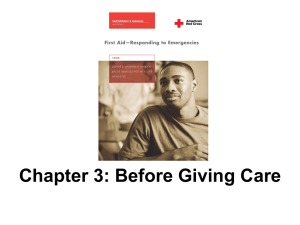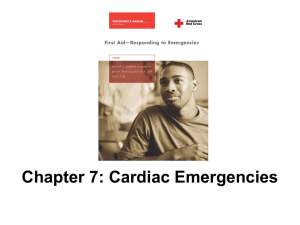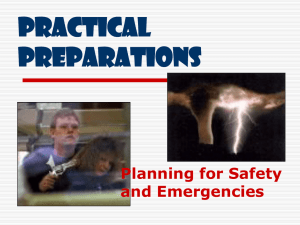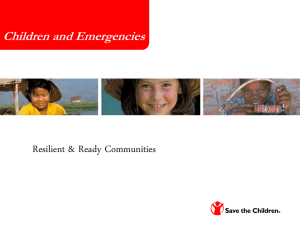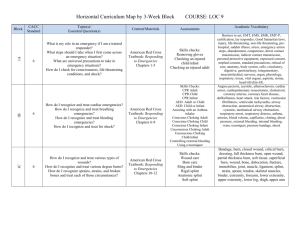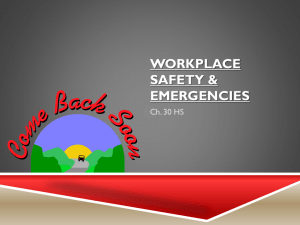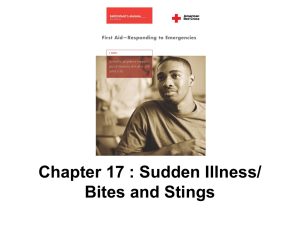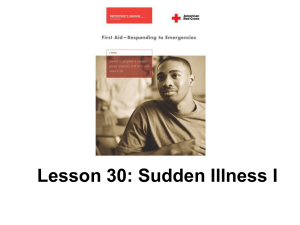Body Systems
advertisement
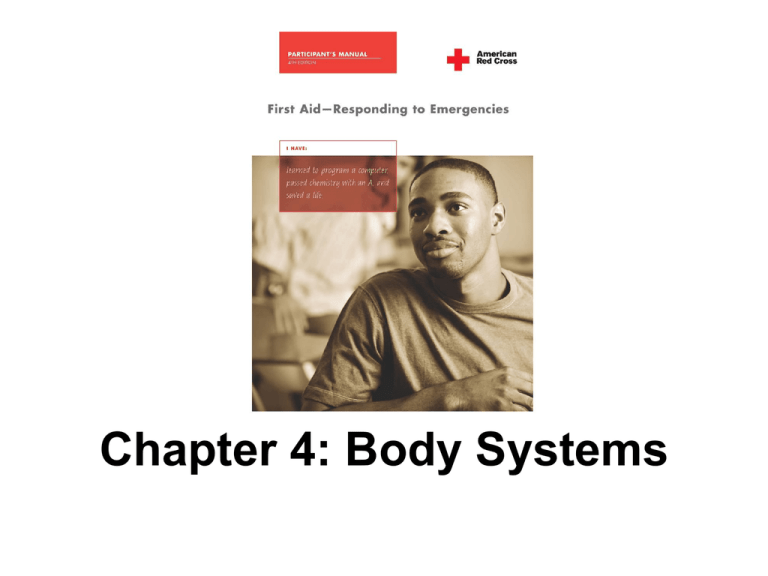
Chapter 4: Body Systems Introduction Understanding the body’s systems and how they interact and depend on each other will help you give appropriate care to an injured or ill person. 2 AMERICAN RED CROSS FIRST AID–RESPONDING TO EMERGENCIES FOURTH EDITION Body Cavities A body cavity is a space in the body containing organs, such as the heart, lungs and liver. Five major cavities: Cranial Spinal Thoracic Abdominal Pelvic 3 AMERICAN RED CROSS FIRST AID–RESPONDING TO EMERGENCIES FOURTH EDITION Body Systems The body is made up of billions of microscopic cells, the basic units of all living tissue. Similar cells form tissues. An organ is a collection of similar tissues acting together to perform a specific body function. 4 AMERICAN RED CROSS FIRST AID–RESPONDING TO EMERGENCIES FOURTH EDITION Body Systems (continued) A body system is a group of organs and other structures that adapt to perform specific body functions. For the body to work properly, all of the following body systems must work well together: 5 Respiratory Integumentary Circulatory Endocrine Nervous Digestive Musculoskeletal Genitourinary AMERICAN RED CROSS FIRST AID–RESPONDING TO EMERGENCIES FOURTH EDITION Body Systems (continued) 6 AMERICAN RED CROSS FIRST AID–RESPONDING TO EMERGENCIES FOURTH EDITION Major Body Systems Activity: What are the major structures of this system? What is the system’s primary function? How can you recognize that the system is working properly? What are some signals that the system is not working properly? 7 AMERICAN RED CROSS FIRST AID–RESPONDING TO EMERGENCIES FOURTH EDITION Interrelationships Among Body Systems Each body system plays a vital role in survival. Body systems work together. The condition that results from the progressive failure of body systems is called shock. 8 AMERICAN RED CROSS FIRST AID–RESPONDING TO EMERGENCIES FOURTH EDITION Respiratory System Activity: If an airway obstruction blockage does not permit air to reach the lungs and prevents oxygen from being circulated to the vital organs, what can happen? 9 AMERICAN RED CROSS FIRST AID–RESPONDING TO EMERGENCIES FOURTH EDITION Circulatory System If a heart attack damages the heart and diminishes or prevents the delivery of oxygenated blood to the vital organs, what can happen? 10 AMERICAN RED CROSS FIRST AID–RESPONDING TO EMERGENCIES FOURTH EDITION Nervous System If a significant injury to the brain occurs, what can happen? 11 AMERICAN RED CROSS FIRST AID–RESPONDING TO EMERGENCIES FOURTH EDITION Musculoskeletal System If an injury occurs that breaks a bone, what can happen? 12 AMERICAN RED CROSS FIRST AID–RESPONDING TO EMERGENCIES FOURTH EDITION Integumentary System If a significant injury occurs to the skin, what can happen? 13 AMERICAN RED CROSS FIRST AID–RESPONDING TO EMERGENCIES FOURTH EDITION Endocrine System If a problem develops with the endocrine system, what can happen? 14 AMERICAN RED CROSS FIRST AID–RESPONDING TO EMERGENCIES FOURTH EDITION Digestive System If a significant injury occurs to a part of the digestive system, what can happen? 15 AMERICAN RED CROSS FIRST AID–RESPONDING TO EMERGENCIES FOURTH EDITION Genitourinary System If an injury occurs to the pelvic area, damaging a part of the genitourinary system, what can happen? 16 AMERICAN RED CROSS FIRST AID–RESPONDING TO EMERGENCIES FOURTH EDITION Closing Each body system plays a vital role in survival. The body systems work together to help the body maintain a constant healthy state. Questions? 17 AMERICAN RED CROSS FIRST AID–RESPONDING TO EMERGENCIES FOURTH EDITION
